Maestro Anthony Galla-Rini
1904-2006
 Anthony
Galla-Rini was born, January 18, 1904 in Manchester, Connecticut, the third of
seven children born to Italian immigrant parents, John & Angela.
Anthony
Galla-Rini was born, January 18, 1904 in Manchester, Connecticut, the third of
seven children born to Italian immigrant parents, John & Angela.
Anthony
started his career in the family band at the age of 5 and when two years later
they began working the Vaudeville circuits. His debut was as an encore, playing
"Casey Jones" on his cornet.
A small lantern was lit and hooked
to the comet and they put an engineer's cap on his head. When it came for the
last chorus all the lights were turned out and all that was seen was Anthony's
face, cornet, lantern and cap. It was at this time that he learned to play the
Accordion, a 3-row button instrument.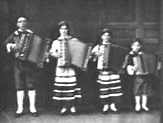 He
had just 6 months of formal education when he joined the family act, known as
"The Galla-Rini Four". Anthony (far right) knew the alphabet by that
time and remembers reading about the sinking of the Titanic in the newspapers.
He
had just 6 months of formal education when he joined the family act, known as
"The Galla-Rini Four". Anthony (far right) knew the alphabet by that
time and remembers reading about the sinking of the Titanic in the newspapers. His
father gave him a book on geography and told him to study it. That was the extent
of his formal education. So you might say he was self-taught, self-made man not
only in academics but also in music.
His
father gave him a book on geography and told him to study it. That was the extent
of his formal education. So you might say he was self-taught, self-made man not
only in academics but also in music.
He spent 20 years in vaudeville and
in that time he had learned to play twelve instruments, woodwinds, brass and the
accordion. The act toured the vaudeville circuit from coast to coast. He played
on the same shows as Mae West, The Marx Brothers, Jack Benny, Jimmy Durante, Eddie
Cantor and many other famous vaudeville acts.
After his sisters broke away
from the family act, when he was 12 years old, his accordion playing became more
important for musical fullness while John showed his versatility on other instruments.
It was during this time that he realized that the accordion was musically complete
in itself. So a deep interest and desire grew in him to play a lot of serious
music on the instrument, bring more personal satisfaction than anything else.
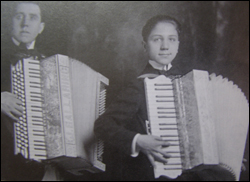 | 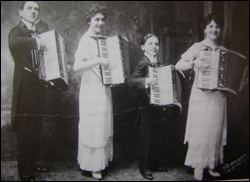 |
Pictures
from Galla-Rini's childhood days performing on the Vaudeville circuit. | |
 | 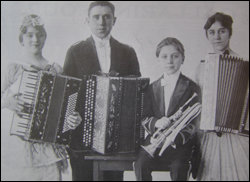 |
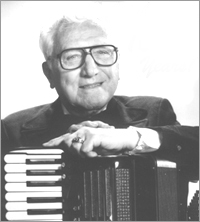 In
1924 he left his father's act because he wasn't receiving his fair share of the
salary. He and his sisters formed their own act that continued until 1932. Their
salary peaked at $600 per week. The Vaudeville years ended with the advent of
Motion Pictures with sound.
In
1924 he left his father's act because he wasn't receiving his fair share of the
salary. He and his sisters formed their own act that continued until 1932. Their
salary peaked at $600 per week. The Vaudeville years ended with the advent of
Motion Pictures with sound.All the entertainers had to find some other kind of work and Anthony decided to open an accordion studio in San Francisco. He published his own accordion method books, started writing music for the instrument, and established himself as a teacher. He also worked on getting the accordion introduced on the concert platform as a solo instrument.
In 1933, he married Dina Petromilli. Three years Iater their son, Ronald Pascal was born. He was hired by the Wurlitzer Music House to be an accordion instructor at the National Music Camp in Interlochen, Michigan. Eventually the family moved to New York City to be close to the various music publishers. He succeeded very well and eventually wrote music for more than 30 publishing houses.
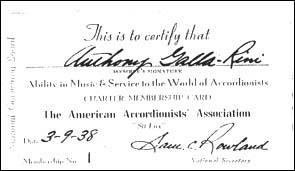 He
was one of the founding members of the American Accordionists' Association (AAA)
in NYC in 1938 (pictured is his membership card, indicating he is member No. 1).
and also a founder of the Accordion Teacher's Guild, International (ATG) in 1941
in Chicago, for which he served as President Emeritus throughout his career. Galla-Rini
also served as a Vice President of the Confederation Internationale des Accordeonistes
(CIA).
He
was one of the founding members of the American Accordionists' Association (AAA)
in NYC in 1938 (pictured is his membership card, indicating he is member No. 1).
and also a founder of the Accordion Teacher's Guild, International (ATG) in 1941
in Chicago, for which he served as President Emeritus throughout his career. Galla-Rini
also served as a Vice President of the Confederation Internationale des Accordeonistes
(CIA).During the spring of that year he began composing his first major work: "Accordion Concerto #1 in G minor", scoring the orchestral part as well as the solo part. It was premiered with the Oklahoma Symphony Orchestra on November 15th of that year with Anthony as soloist.
Galla-Rini returned to California in 1942 and taught accordion again. A year later, he joined a rumba band playing at the Trocadero, one of the most prominent nightclubs on Hollywood's Sunset Strip. There were no written accordion parts, so he had to improvise.
This led to opportunities to play on sound track engagements in the Hollywood film industry. You can hear him playing on such films as: High Noon, Laura, Carnival at Costa Rica, Rhapsody in Blue, Shine of Harvest Moon, The Gunfighter, A Tree Grows in Brooklyn, and the Sting 11 just to name a few.
During the next decade, he performed on concert tours in various theaters across the US He also toured England, Scotland, Norway and Sweden in 1950, taking his family with him.
 In
1951 he represented the ATG at the CIA General Assembly and Coupe Mondiale in
Paris, which resulted in the CIA accepting the ATG as a member organization. In
1958 and 1959, he performed as a guest artist in Carnegie Hall. In 1960 he was
elected to the Accordion Hall of Fame, sponsored by the Arcari Foundation.
(Pictured right are Mr. Galla-Rini and long time friend Joan C. Sommers.)
In
1951 he represented the ATG at the CIA General Assembly and Coupe Mondiale in
Paris, which resulted in the CIA accepting the ATG as a member organization. In
1958 and 1959, he performed as a guest artist in Carnegie Hall. In 1960 he was
elected to the Accordion Hall of Fame, sponsored by the Arcari Foundation.
(Pictured right are Mr. Galla-Rini and long time friend Joan C. Sommers.)In 1968, Dina Galla-Rini passed away. Three years later, Anthony married Dolly Cortella. He was married to her until she passed away at the age of 101.
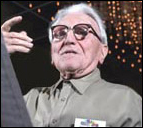 In
1975, the President of Italy conferred on him the title of "Cavalier of the
Star of Solidarity" in recognition of his efforts towards strengthening the
cultural bonds between Italian and American people and for his interest in the
development of the Italian accordion in American activities.
In
1975, the President of Italy conferred on him the title of "Cavalier of the
Star of Solidarity" in recognition of his efforts towards strengthening the
cultural bonds between Italian and American people and for his interest in the
development of the Italian accordion in American activities.The following year he composed Accordion Concerto No. 2 in E minor (in three movements) for free-bass system. And in 1983 he composed "Sonata in D minor" for accordion (in three movements).
Since 1990, at age 86, Galla-Rini has held an Accordion Camp every summer where he gives workshops and conducts ensemble work. He was the first person to be inducted in the ATG Hall of Fame on his 99th birthday in 2003.
 Being
featured as soloist with over 15 symphony orchestras, Galla-Rini has played on
numerous recordings with several record companies. He has arranged hundreds of
transcriptions from orchestral works for accordion ensembles, orchestras, soloists
and students. His advanced arrangements are quite challenging but well worth the
effort. (Mr. Galla-Rini is pictured above with his ATG Festival Birthday Orchestra
which he conducted by memory during his 99th Birthday celebrations in San Diego,
CA.)
Being
featured as soloist with over 15 symphony orchestras, Galla-Rini has played on
numerous recordings with several record companies. He has arranged hundreds of
transcriptions from orchestral works for accordion ensembles, orchestras, soloists
and students. His advanced arrangements are quite challenging but well worth the
effort. (Mr. Galla-Rini is pictured above with his ATG Festival Birthday Orchestra
which he conducted by memory during his 99th Birthday celebrations in San Diego,
CA.)He is credited with many pioneering efforts such as: standardizing the stradella system, notating exact pitch of all the 5 sets of reeds in the left hand, notating the left hand in bass clef, and the logical choice and placement of the right hand and left hand registers.
He will be forever remembered for his lifetime of musical achievements and extraordinary contributions to the accordion world.
Saturday, August 12, at 2:00 PM
Olive Branch Community Church
7702 El Cerrito Rd.
Corona, CA 92881
Note: The best airport to fly into is the Ontario, CA Airport since it is only about 30 minutes from the church; LAX is approximately 2 hours away. Visitors are welcome at Ron and Jan Galla-Rini's home both before and after the memorial service.
Donations, if desired, may be given to the "Galla-Rini Memorial Fund" with proceeds going to a possible scholarship for the Galla-Rini Camp.
Personal condolences may be sent to his son at the following addresses:
Ronald Galla-Rini
9185 Stone Canyon Rd.
Corona, CA 92883
E-mail: Rongee_3@hotmail.com
Tel: (951) 277-210